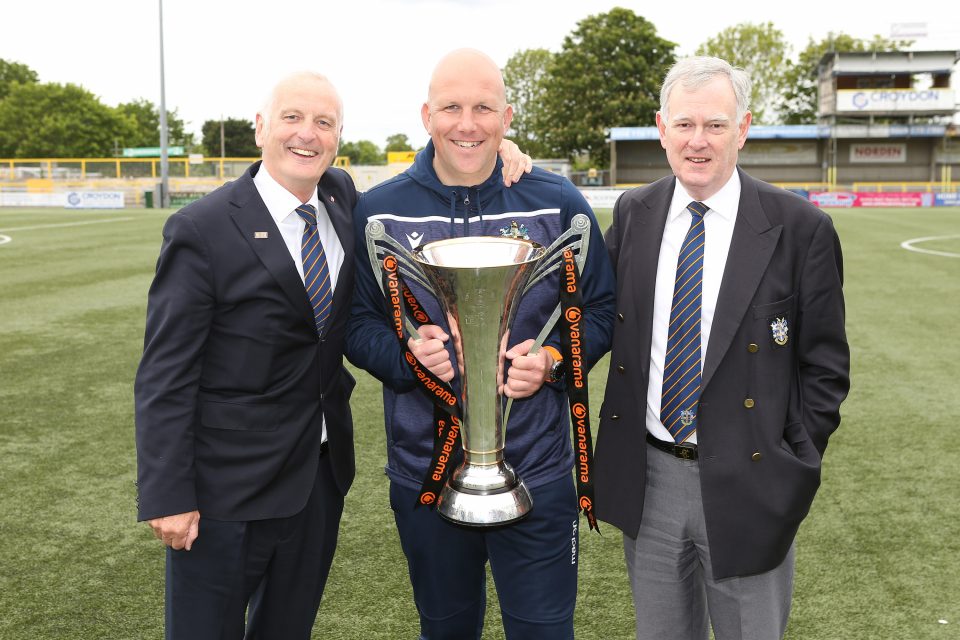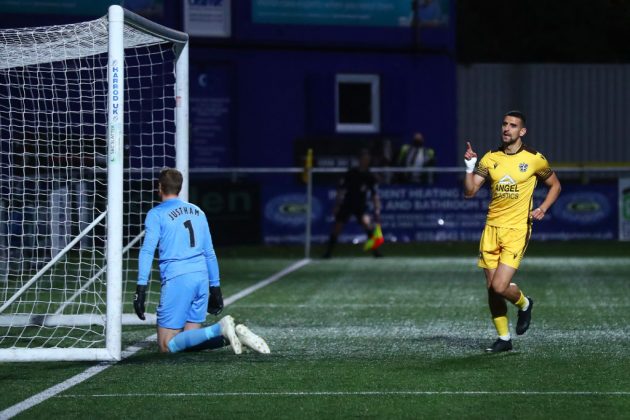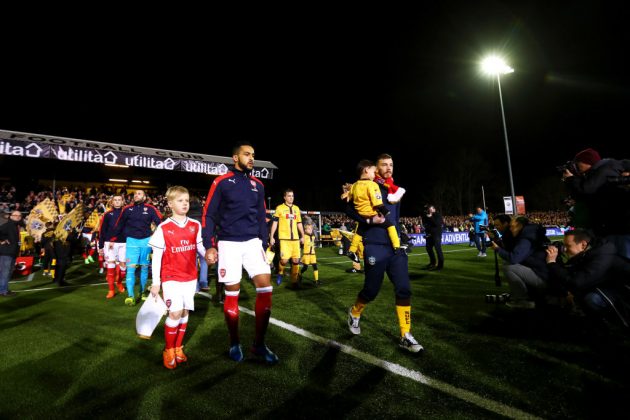Sutton United: How the non-league lifers did a Leicester – and why they have had to transform the club for their debut season in the EFL

Sutton United’s long-serving chairman Bruce Elliott has more than one reason to look forward to today’s trip to Forest Green Rovers.
Elliott’s overriding emotion will be pride that the club he has been involved with for half a century has reached the English Football League (EFL) for the first time in their 123-year history.
But he will also be glad of the respite that 90 minutes of football promises from a frantic summer of preparations for Sutton’s step into the unknown.
“It will be quite a relief watching the players come out at Forest Green and thinking ‘for the next hour and a half we don’t have to worry too much about off the pitch’,” Elliott says.
Sutton’s reward for a promotion so improbable that it has drawn comparisons with Leicester City’s Premier League title win has been to be forced into overhauling the club.
As a team who have only ever known life in non-league football and barely dreamed of EFL status, little at Gander Green Lane was ready for full-time professionalism.
That has all had to change in just a few short weeks as Elliott, manager Matt Gray and an army of volunteers have worked around the clock to ready the club for League Two.
“It’s been a bit of a whirlwind,” says Gray, the 39-year-old rookie manager who led Sutton to their historic promotion in just his second season in charge.
Sutton forced to rip up pitch – and business plan
The biggest project Sutton have had to undertake in the close season is removing and replacing the 3G artificial pitch that has been a key pillar of their business model since 2015.
Having an all-weather surface allowed them to not only train at their stadium but also hire it out for community use, earning the club £200,000 annually.
But despite international football permitting 3G pitches, the EFL does not, so Sutton have had to fork out £550,000 for a new grass-hybrid surface.
They have made other stadium improvements, including new floodlights, seats in the away end, turnstiles and Wi-Fi.
Sutton have also had to find new land for the team to train on, as well identify a site to house their old 3G pitch and the legion of other teams who depend on it.
On top of all that there has been a mountain of paperwork, in no small part because all players needed new contracts to reflect their full-time status.
Elliott says that the club’s transformation will swallow up the vast majority of the approximate £1m windfall earned by promotion.
“I think we probably didn’t quite realise what was involved,” says Elliott.
“You might say that was naivety, but we had never been in the Football League before whereas a lot of other clubs vying for promotion last year had been.”
Why Sutton’s success took even them by surprise
To understand the magnitude of Sutton’s story, it’s worth revisiting the history of a club that finished 15th in 2019-20 and was playing in the sixth tier until five years ago.
They are perhaps best known for two FA Cup runs: 1988-89, when they beat top-flight Coventry City, and 2016-17, when they hosted Arsenal in the fifth round.
This time last year, manager Gray’s instructions were simply to keep them in the National League among bigger names such as Notts County, Stockport County and Chesterfield.
Elliott says he has exhausted the joke about Gray failing miserably, having clinched top spot in the fifth tier in their penultimate fixture on 23 May.
“Did it take us by surprise? Yes I think it probably did,” he says. “I’m not sure anybody realistically expected that we would come out on top.”

Gray is more emphatic: “I don’t think anyone – anyone – would have tipped us to win the league.
“And it’s borderline a miracle that it happened given the size of the clubs and budgets in the National League.”
Elliott says it has been hard to compute the magnitude of their achievement while being at the centre of it.
“I don’t think we quite realise what the players and manager have achieved,” he adds.
Promotion proves ‘it’s not all about the money’
So just how did Sutton beat the odds and become the Leicester of the National League?
Gray puts it down to “all components of the club facing in the right direction” and a recruitment policy that prioritised “the right characters”.
Elliott emphasises the importance of continuity, as you might expect from a man who has been chairman for 25 years. “It gets into your blood a little bit,” he says.
He has always tried to run Sutton sustainably, and made sure they invested the £1m payday from their last cup run in new dressing rooms, toilets and a scoreboard.
A business model supported by their 3G pitch made them a non-league case study to copy, and others, such as nearby Bromley, have followed their path.

In a neat twist, Sutton’s first home match of the season is against Salford City, whose own rise to the EFL owes much to the deep pockets of former Manchester United stars and a billionaire.
Sutton’s success “goes to prove it’s not all about the money”, says Gray. “If you’ve got the right people pulling in the right direction, that’s the core values you need – in business or sport.”
Non-league budgets don’t cover League Two costs, however, much less so after a pandemic and despite loyal fans donating £60,000 to cover some of the club’s lost income.
“It will be a different financial model,” says Elliott. “But, being honest, until we’ve done the first year [in the EFL] it’s almost impossible to know how it’s going to pan out.”
Rain puts the skids on new turf installation
A few days out from their EFL debut, Elliott, Gray and all at Sutton were still working flat out behind the scenes to get ready.
They are happy to have sold 1,500 season tickets, even if those figures would barely register at other League Two sides, such as Swindon Town and Bradford City, once of the Premier League.
Frequent downpours have interrupted work on the new playing surface, but they are optimistic that it will be ready for the visit of Salford on 14 August.
“We’re keeping our fingers crossed,” says Elliott. “But we can’t control the weather and that’s a major factor in putting down a new pitch in a short space of time.”

Before then, they visit Cardiff City in the Carabao Cup. Elliott hopes that further favourable cup draws boost the coffers as they adjust to new financial realities.
Gray, meanwhile, has kept together the core of a team captained by former Arsenal midfielder Craig Eastmond and is relaxed about the switch from 3G to grass.
“I think there is a slight difference in the surfaces but we were good on whatever we had to play on,” he says. Sutton won an impressive 38 of their 84 points away from home last term.
Beginning life in the EFL ‘exciting and daunting’
Elliott accepts Sutton “will probably be in for a shock at some places we go to” and will be more than satisfied with surviving in League Two.
“We’re going into the unknown a little bit,” says Elliott. “I don’t know how big a step up it is, if I’m being honest, from National League to League Two, but we’re about to find out.”
Sutton can take heart from the fact that eight of the last 10 teams to go up are still in the EFL, with two even achieving further promotions.
“We don’t particularly want to be the first club for some years to come straight back down,” says Elliott. “That really isn’t the objective.
“We were pinching ourselves when we went to Notts County and Chesterfield [in the National League] because they are big clubs. I think we’ll be doing that a few more times this season.
“It’s quite exciting and daunting at the same time.”
As he did last year, Gray will start the campaign with a simple target: 50 points and survival.
After that, he says, “you just never know. If you’ve got a group of people who stick together, absolutely anything is possible.”
